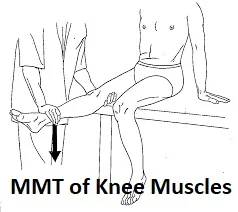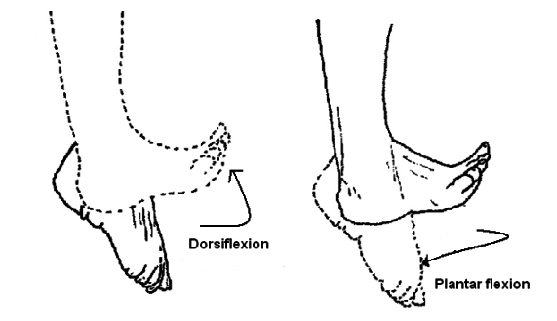Anterior Drawer Test of Ankle Joint
Table of Contents
Introduction
The Anterior Drawer Test of Ankle Joint is a physical examination test used to assess the integrity of the lateral collateral ligaments of the ankle, specifically the anterior talofibular ligament. It is one of the most common tests used to diagnose ankle sprains.
Specifically, the anterior talofibular ligament (ATFL), calcaneofibular ligament (CFL), and posterior talofibular ligament (PTFL) are examined during the anterior drawer test of the ankle, an orthopedic procedure that determines the health of the lateral ankle ligaments. It is one of the procedures used most frequently to check for ankle instability.
Purpose
Checking for ligament laxity or instability in the ankle is the goal. The strength of the anterior talofibular ligament is largely evaluated by this test.
Test Position
Supine position or Sitting position.
Performing the Test:
With one hand, the examiner stabilizes the front distal leg; with the other, they grip the patient’s calcaneus and back foot. The examiner next moves the patient’s back foot anteriorly and plants the patient’s foot in 10-15 degrees of plantar flexion. If the talus moves forward during the test, it is successful. Positive test findings are sometimes rated on a “0 to 3 scale”, with 0 indicating no laxity and 3 signifying severe laxity.
Result of the Anterior Drawer of the Ankle :
However, the anterior drawer test is higher if both ligaments are damaged, especially if the foot is examined in dorsiflexion. A positive anterior drawer test can still be accomplished with simply a tear of the anterior talofibular ligament.
The test shows inadequate medial and lateral ligaments if there is straight anterior movement or translation.
This bilateral finding, which is frequently more obvious in dorsiflexion, indicates that the anterior talofibular ligament and anterolateral capsule, as well as the superficial and deep deltoid ligaments, have all been ruptured.
Only the side with the tear would translate forward if there was only one.
For instance, a lateral rupture would cause the lateral side to translate forward, resulting in medial rotation—an internal rotation of the talus—and anterolateral instability, which becomes more obvious with increased plantar flexion of the foot.
For the Achilles tendon to feel less tense, the knee should be bent 90 degrees.
To test for straight and rotational instabilities, the test should be done in both plantar flexion and dorsiflexion.
Diagnostic Accuracy:
Sensitivity:.71; Specificity:.33; +LR: 1.06; -LR:.88;
Importance of Test: After an inversion ankle sprain (damage to the lateral collateral ligaments), the anterior drawer test is a helpful test to give to the patient. The anterior talofibular ligament (ATFL), calcaneofibular ligament, and posterior talofibular ligament are the three primary parts of the ankle’s lateral collateral ligaments. The ATFL runs from the medial anterior aspect of the neck of the talus to the medial anterior aspect of the lateral malleolus.
The ATFL’s function is to oppose anterior ankle translation and prevent the talus on the tibia from rotating inward. According to the anatomical orientation, the ligament is stressed when the ankle is in 10-15 degrees of plantar flexion, and this stress is increased when a posterior-to-anterior translation is used. Given that laxity is graded subjectively (0–3), it is crucial for the beginning physician to evaluate the motion and patient response during the exam.
Evidence
When compared to an arthrogram, the anterior drawer had a sensitivity of 86% and a specificity of 74% for diagnosing 160 individuals with an inverted ankle sprain. Croy et al. examined the diagnosis accuracy of the anterior drawer test of the ankle in 66 participants with a history of lateral ankle sprain in a prospective, blinded, diagnostic-accuracy research. The talofibular interval was digitally assessed while performing the anterior drawer test using ultrasound imaging.
The anterior drawer test’s sensitivity was 0.74 (95% confidence interval [CI]: 0.58, 0.86) and 0.83 (95% CI: 0.64, 0.93) at the reference standards of 2.3 mm or more and 3.7 mm or greater, respectively. The test has a 0.40 (95% CI: 0.27, 0.56) and 0.38 (95% CI: 0.24, 0.56) specificity, respectively. Negative probability ratios were 0.66 and 0.41, respectively, whereas positive likelihood ratios were 1.2 and 1.4. The anterior drawer test was discovered to be a useful technique for detecting mechanical ankle instability in recent cross-sectional diagnostic research.
Limitations
It is not a perfect test, the anterior drawer test. The proper execution can be challenging, and the patient’s discomfort and muscular tension may have an impact on the outcome. Additionally, even in individuals with ankle sprains, the test may come out negative.
The anterior drawer test is a helpful and reliable technique for identifying ankle sprains in general. The test must, however, be evaluated in combination with other clinical data, such as the patient’s medical history and results of a physical examination.
FAQ
The most frequent method for identifying lateral ligamentous instability is anterior drawer testing of the ankle. We reasoned that altering the knee and ankle postures during an anterior drawer test would alter the stability of the ankle joint.
When compared to an arthrogram, the anterior drawer had a sensitivity of 86% and a specificity of 74% for diagnosing 160 individuals with an inverted ankle sprain.
When compared to the undamaged foot, the test is positive if there is an excessive anterior movement of the foot and dimpling of the skin on both sides of the Achilles tendon. A positive test results in a ruptured anterior talofibular joint.
An orthopedic examination called the Prone Anterior Drawer examination is used to evaluate the health of the anterior, calcaneofibular, and posterior talofibular ligaments, which make up the lateral collateral ligaments of the ankle.
Reference
- n.d., Anterior Drawer of the Ankle. Physiopedia. https://www.physio-pedia.com/Anterior_Drawer_of_the_Ankle
- (Undated) Anterior Drawer. The Learner? Therapist for the body. https://www.thestudentphysicaltherapist.com/anterior-drawer.html
- Those authors are Nyska, M., Amir, H., Porath, and Dekel (1992, September 1). Modified Anterior Drawer Test of the Ankle Radiological Evaluation. SAGE Publishing; Foot & Ankle. https://doi.org/10.1177/107110079201300707
- Hollis, J. M., Heitman, R. J., Kovaleski, J. E., Norrell, P. M., & Pearsall, A. W. (2008, May 1). Position of the knee and the ankle, laxity of the anterior drawer, and stiffness of the ankle complex. National Athletic Trainers’ Association; Journal of Athletic Training. https://doi.org/10.4085/1062-6050-43.3.242
- Ankle Anterior Drawer Test | Medical Bridge, n.d. MedBridge. https://www.medbridge.com/exam-tests/test/271/
- V. Ladva. October 20, 2022. Mobile Physiotherapy Clinic: Anterior Drawer of the Ankle. https://mobilephysiotherapyclinic.in/anterior-drawer-of-the-ankle/






